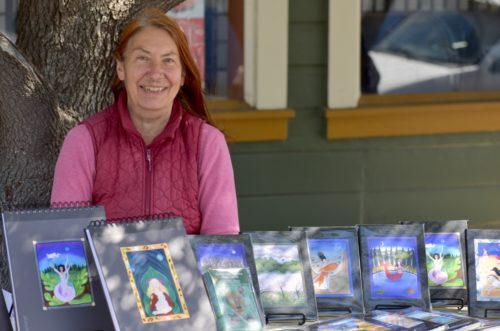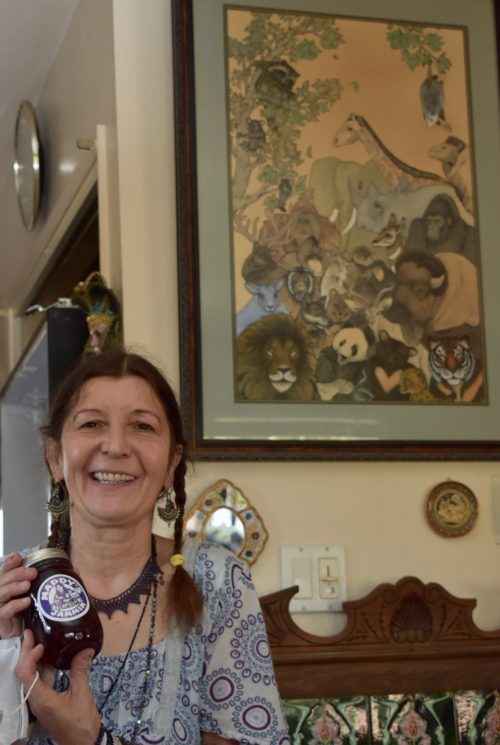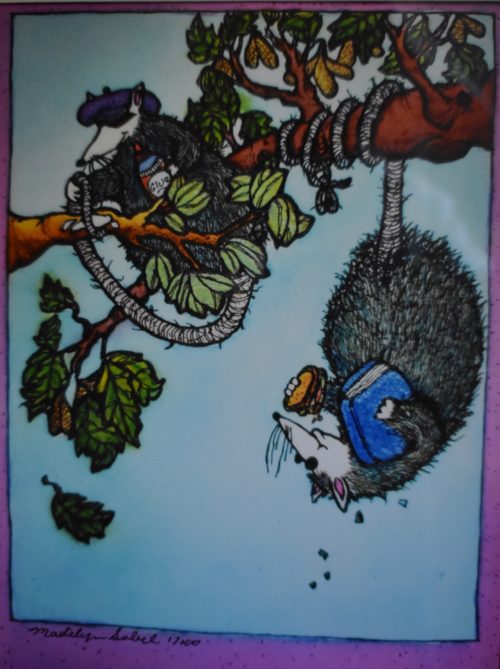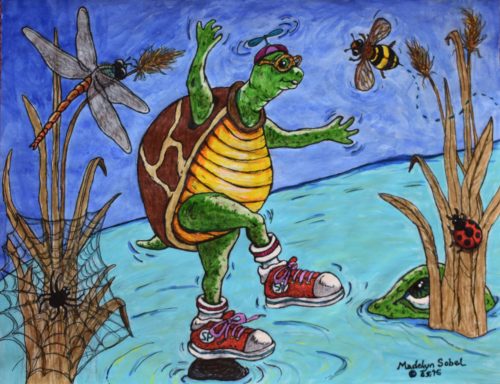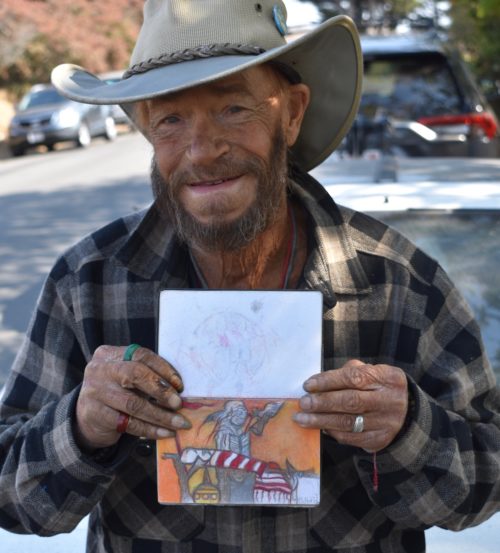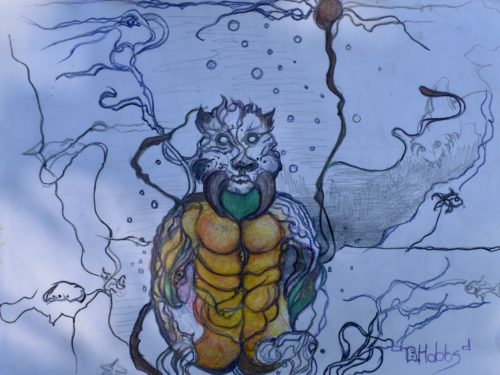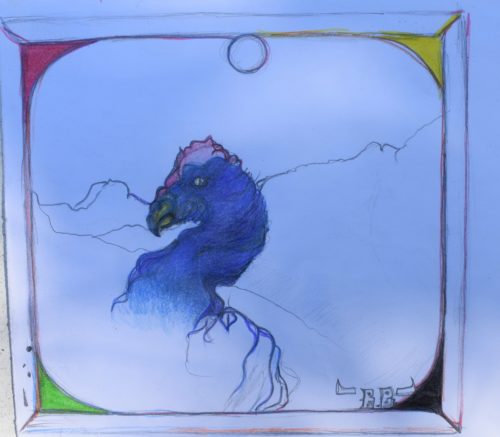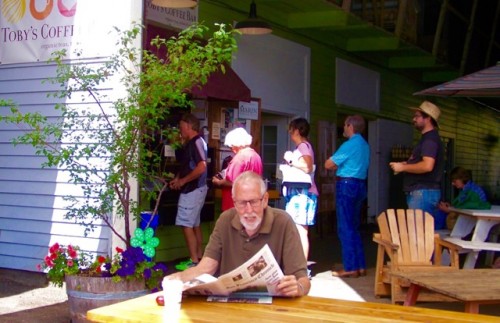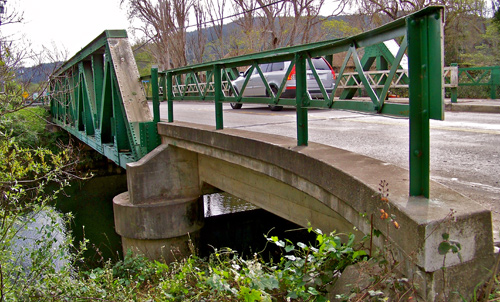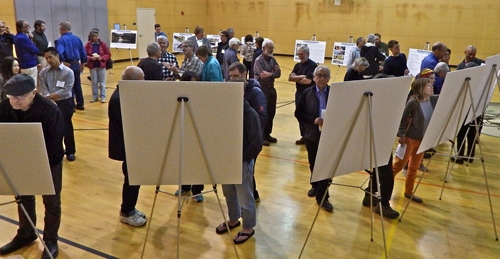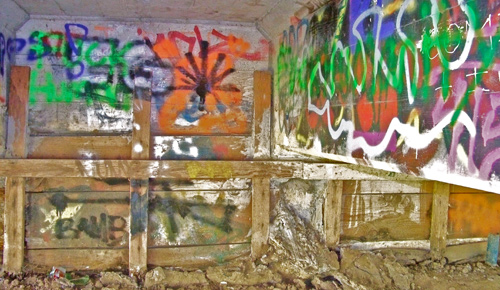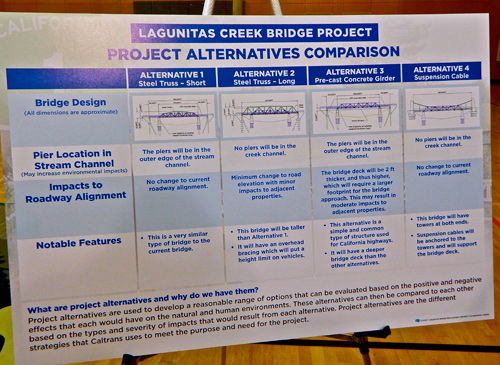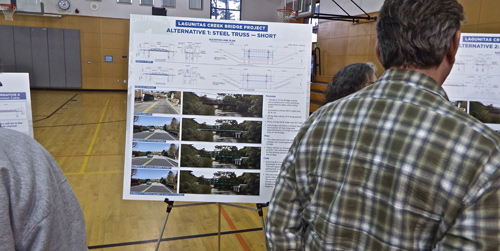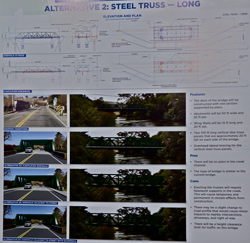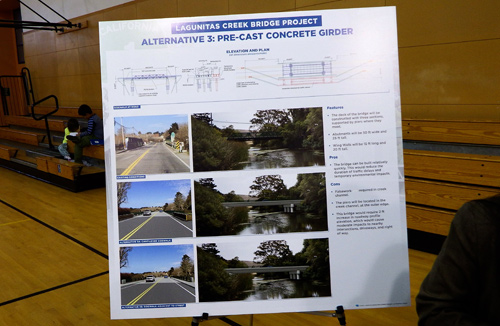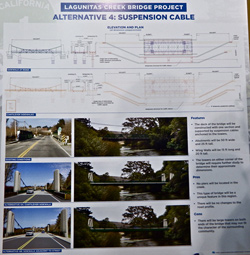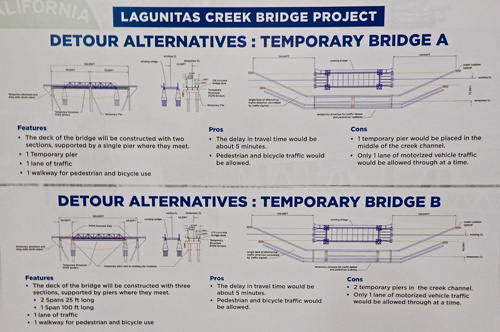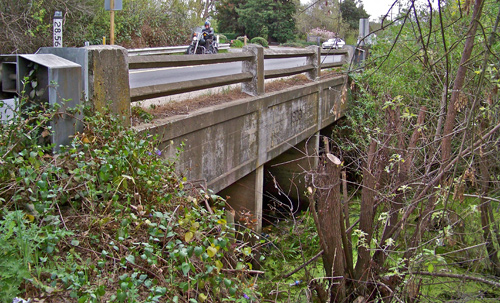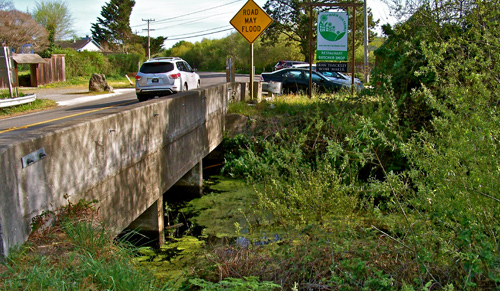Entries tagged with “Point Reyes Station”.
Did you find what you wanted?
Sat 1 May 2021
Posted by DavidMitchell under Uncategorized
1 Comment
Caveat lectorem: When readers submit comments, they are asked if they want to receive an email alert with a link to new postings on this blog. A number of people have said they do. Thank you. The link is created the moment a posting goes online. Readers who find their way here through that link can see an updated version by simply clicking on the headline above the posting.
_______________________
A row of flowerpots now parades down the raised section of sidewalk on the main street of Point Reyes Station (between C and D streets). The story behind this array of flowerpots is intriguing.
The town was born in 1875 when the North Pacific Coast Railway opened a narrow-gauge line from Sausalito to Cazadero with a stop in Point Reyes Station. What started as a whistlestop in a cow pasture owned by Mary Burdell became a town subdivided by her husband Galen, a dentist. Soon there was a depot on the main street, but it was turned 180 degrees when tracks east of town were converted to standard gauge in 1920.
Back in the days of the narrow-gauge trains, the building housing Cabaline Saddle Shop and the Bovine Bakery housed a general store, the Point Reyes Emporium. The train tracks went up the the middle of the main street, which was not yet paved, meaning that in wet weather, workers transporting cargo from a boxcar to the store had to slog through mud.

The raised sidewalk with two people sitting on its edge in the way many did until recently.
Their solution was to build a sidewalk as high as the floor of a narrow-gauge boxcar. When a train stopped in front of the Point Reyes Emporium, workers stuck sawhorses in the mud, laid planks on top of them, and then had a level, dry passage from the floor of the boxcar to the door of the store.
The narrow gauge up the coast shut down in 1930, and the standard gauge east of town closed in 1933. The line had never been profitable, and the Great Depression, along with the advent of competition from trucks, brought about the end of West Marin’s railroad era. The former Point Reyes Station depot is now the town post office.

The raised section of sidewalk flowered this year. The Bovine is to the left of Leona’s.
The town was left with a raised section of sidewalk which became an unexpected problem during the pandemic. The already-popular Bovine Bakery became even more so as out-of-towners escaping the monotony of sheltering at home frequently chose West Marin for an escape, stopping by the Bovine for a snack. In order for the bakery to maintain proper social distancing, customers for now don’t go inside but get their pastries at the door.
Many of them had taken to eating their pastries sitting just outside on the edge of the raised section, and as inevitably happens when people eat pastries beside the street, birds show up for the crumbs some folks throw them. Before long, Leona’s next door began finding an overabundance of people and birds nibbling at the door. Messy. The solution? Flower pots so folks can’t use the edge of the raised section for a bench.
Wed 30 Sep 2020
Posted by DavidMitchell under The arts
1 Comment
Caveat lectorem: When readers submit comments, they are asked if they want to receive an email alert with a link to new postings on this blog. A number of people have said they do. Thank you. The link is created the moment a posting goes online. Readers who find their way here through that link can see an updated version by simply clicking on the headline above the posting. All other readers already have an updated version.
For a small town, Point Reyes Station (pop. 848 at last count) has long had a lively art scene with galleries, artists selling their work on the streets and even creating art there. Here are three examples of the town’s highly diversified art community.

Christine DeCamp selling her art in front of the Point Reyes Station post office last Saturday. She has also sold from a studio. Until the pandemic slowed businesses down, many of us also knew her as a server at the Station House Café. Here are three more of her paintings:

Our Lady of the Mountain
Mountain Goddess…/ sheltering all creatures/ within her domain. Her/ interior is the mysterious/prima materia or the/beginnings of ‘all is/ possible’. The magical/ deer are symbolic of/ rebirth and rejuvenation.
copyright 2012 Christine DeCamp

Wild Spirit Wisdom

Clyde
Clyde the rider Crow with/ Blue eyes that SEE. He is/ being carried by Navajo spirit/ horse who embodies SEEING/ and brings forth living springs/ with each step. Can you hear/ the drums? A magical journey
copyright 2011 Christine DeCamp

Maddy’s Jammin’ with its balloon-adorned sign has for years been a familiar sight along Highway 1 a half block downhill from West Marin School. Before this year, Maddy Sobel also sold her jams in front of the post office on weekends and, like Christine, also sold her art there.

The Animal Kingdom, Mammals. Maddy, standing in front of one of her large paintings, which is hanging in her living room, shows off a jar of her blackberry jam. These days, she has to sell her art mostly from home.

Hang in There exemplifies Maddy’s often-whimsical style.

Timmy the Tiny Turtle

Another artist with a creative imagination is Billy Hobbs. Almost all his art these days reflects Greek mythology, Hindu scripture or Native American history. This drawing is titled ‘Lakota Burial.’

Billy’s Saber-toothed Tortuga is eye-catching even before revealing its subtleties.

Billy is still working on his drawing ‘Condor.’ The artist is homeless and sleeps in my second car, which I park downtown on Mesa Road for him. To comply with the law, I have to move the car every three days. My car meanwhile has also become the studio where Billy does his drawing.
Billy, 62, has been homeless for seven years following the breakup of a 25-year marriage. Several organizations are supposedly trying to find permanent shelter for him but have been looking for more than a year. I first got to know him pre-pandemic when he’d frequently do his drawing while sitting on a bench outside the post office. In those days, I typically had my morning mocha at one of Toby’s Coffee Bar’s nearby picnic tables.
Mon 19 Sep 2016
Hello again. After posting on this blog every week for 10 years, I abruptly stopped without explanation 14 months ago. Well, I’m back. Here’s what happened.
Keeping me away had been some damnable eye problems: first, temporal arteritis (an inflammation of the artery through my temples that feeds blood to my eyes); second, botched cataract surgery on my left eye.
The temporal arteritis began with an extreme headache in my scalp that ultimately required half a day in Kaiser’s emergency room. I was prescribed a lengthy, perhaps too lengthy, regimen of Prednisone (a steroid). It stopped the pain and prevented me from going blind, but some of its side effects are still with me. My balance standing and walking is not what it should be.
The botched surgery, which occurred in January, is also continuing to take its toll. I should have been forewarned when the surgeon often seemed impatient discussing the operation in advance. During the surgery, she nicked the inside of my left eyeball, causing the lens to start falling out.
The result was double vision and poor focus. I’ve now received two more operations from another surgeon to repair the damage. The lens has been stitched onto the eye’s retina, and my vision is improving. I won’t need another operation if the progress continues, but that won’t be determined for sure until November.
In any case, as a result of my Prednisone problems and damaged left eye, I needed some R&R and stopped posting.
A secondary problem with the cataract surgery was to postpone dental surgery that was glaringly needed as a result of breaking off two front teeth last December. Because of the eye surgeon’s concern that the dental surgeon’s painkillers could interfere with her cutting into my eyeball, I had to spend half a year without two prominent teeth.
In an unsuccessful effort to hide the gaps, I began wearing my moustache extra long. Finally, after the last eye operation, I was able to get my dental surgery, which, in turn, meant I could resume trimming my moustache back and no longer feel slightly self-conscious whenever I smiled in public.

The No Name Bar in Sausalito is an unusually friendly place, and now that my moustache and teeth are fixed, I can again openly enjoy the Michael Aragon Quartet. (Photo by David Fischer)
Like many people in frustrating circumstances, I’ve dealt with my woes by hitting the bars. I was already going to the No Name Bar in Sausalito almost every Friday night to mingle with Bay Area illuminati and listen to great jazz. As it happens, I’m a fan of the Michael Aragon Quartet, which has performed at the No Name virtually every Friday for 33 years.
The No Name has a patio out back where there’s frequently a chess match, and smoking is permitted. People mingle easily as if they were all at a cocktail party. My usual “cocktail” at the party, by the way, is an Irish coffee.

Sarah Burke, server, and J.J. Miller, the barkeep, at the No Name.
I don’t know if it’s coincidence or merely that I like coffee, but the other bar where I hang out is Toby’s Coffee Bar in Point Reyes Station. Most days in early afternoon, I sit at an outdoor table reading the morning Chronicle, drinking a mocha, and chatting with friends as they walk in and out of the post office next door.

Reading The San Francisco Chronicle while getting a tan at Toby’s Coffee Bar. (Photo by Lynn Axelrod)
It’s a cheerful spot, and I spend enough time there that a few townspeople have started to refer to my table as my “office.” Were I consuming booze instead of coffee, by now I’d be one of the town toss-pots (the term at the end of A Midsummer Night’s Dream that Shakespeare uses for sots).

Barista Jenna Rempel of Inverness at Toby’s Coffee Bar.
Because I’m now living life in the slow lane, I’m able to resume blogging, but it remains to be seen whether I’ll be able to do so every single week as in the past. At least for the moment, I have enough material on hand to keep going for a while. So goodnight for now. It’s good to see y’all again.
Sun 22 Mar 2015
Posted by DavidMitchell under General News, Point Reyes Station
Comments Off on Caltrans meeting about replacing Green Bridge draws mixed responses
A crowd of Tomales Bay area residents showed up at West Marin School Thursday to look over Caltrans plan to replace the Green Bridge in Point Reyes Station. The bridge carries an average of 3,000 vehicles on Highway 1 over Papermill Creek daily.

Caltrans would like to spend approximately $5.8 million to replace the 100-foot-long bridge, beginning in 2018 or 2019 and finishing three or four years later.

A team of Caltrans representatives were on hand Thursday to explain diagrams of four alternative designs for the replacement: a short, steel-truss bridge; a long, steel-truss bridge; a precast, concrete girder bridge; and a suspension bridge.

The underside of the Green Bridge.
“The current bridge was determined to be seismically deficient, and retrofitting the bridge was deemed infeasible due to limitations caused by the nature of the original structure,” Caltrans reported earlier. The bridge was built in 1929.

The alternative designs differ in: how the piers will affect the creek channel, affect neighboring properties, and alter the approaches to the bridge. They also differ in bridge height and in the thickness of the deck.

The short-steel-truss design is “very similar” to the present bridge, Caltrans says. ________________________________________________________________
 The long-steel-truss design would be taller than the existing bridge.
The long-steel-truss design would be taller than the existing bridge.
It would have overhead bracing, which would put a limit on the height of vehicles that could use it.
Approximately 120 of the vehicles that now cross the bridge each day are trucks.
____________________________________________

Under this alternative, the bridge deck would be two feet thicker than it presently is. It would also cover more land and water, and this would have “moderate impacts to adjacent properties,” Caltrans noted. _______________________________________________________________
 The suspension-cable design under consideration would have towers at each end, anchoring the cables supporting the bridge deck.
The suspension-cable design under consideration would have towers at each end, anchoring the cables supporting the bridge deck.
There would be “no piers” in the creek and there would be “no change to the current road alignment,” according to the state.
______________________________________________________________________

A spot check of residents attending Thursday’s meeting found many people skeptical of the need to replace the bridge but resigned to it.
The hot-button issue was what will happen to traffic on Highway 1 and the intersecting levee road during the estimated 18 to 24 months of rebuilding. Caltrans has two alternative proposals for a temporary bridge, but each would be able to accommodate only one direction of traffic at a time.
Provision would be made for bicycle and pedestrian traffic, and a stoplight would be installed to regulate vehicle traffic. Vehicle delays would be “about five minutes,” the highway department predicted. The traffic jams on a summer weekend would be huge, numerous people warned.

A bridge too far?
Coming in for virtually no discussion was a smaller bridge about 60 yards north of the Green Bridge. This Highway 1 bridge was also built in 1929, but no mention was made of its condition.

Another bridge too far?
Also left unmentioned was a second small bridge, which is about 50 yards south of the Green Bridge near Marin Sun Farms. What’s the condition of its piers? I wasn’t about to wade around in the muck to find out.
A “draft environmental document will be made available for public review and comment in mid-2016,” according to Caltrans. “The final environmental document is expected to be issued by early 2017, and design completion will be in late 2018.
“Construction is expected to begin in three to four years and last approximately two to three years.”
People wanting to have their concerns considered in Caltrans’ planning can write the state at: <lagunitas_bridge@dot.ca.gov>.
Sun 7 Dec 2014
Posted by DavidMitchell under Point Reyes Station
Comments Off on Despite a series of downpours, Point Reyes Station steps out to celebrate the Yuletide
Despite a drizzle that at times became a downpour, crowds turned out Friday evening in Point Reyes Station to celebrate the Yuletide.
It was a town-wide celebration: a Path of Lights on the main street, a Holiday Crafts Fair in the Dance Palace, a party with live music at Point Reyes Surf Shop, and a Christmas party including Santa Claus and carolers in Toby’s Feed Barn.

West Marin Senior Services sponsored a Lights of Life tree-lighting ceremony to honor loved ones who have passed away. The pine, which grows in the median between the Wells Fargo Bank and the Palace Market parking lots, each year takes on added significance as the town Christmas tree.
The Path of Lights is symbolized by a line of luminaria along the main street, and the luminaria unfortunately suffered from the wet weather. Luminaria, of course, are small lanterns consisting of candles standing in sand inside a paper bag. It took only a couple of downpours for the splash to extinguish several lights.

The crowd outside Wells Fargo Bank.
Strumming her guitar, Harmony Grisman again this year led a crowd in singing songs of the Yuletide.

The 44th annual Holiday Crafts Fair in the Dance Palace.
The obvious skill in the work of clay artist Molly Prier of Inverness inspired praise from fair-goers.

Dusty Rose Designs brightened a corner of the Dance Palace with tie-dye-style clothing.

Eden Clearbrook from the Garden of Eden sold herbal elixirs.

Ana Maria Ramirez (center) and Lourdes Romo sold handmade clothing and accessories.

The annual Christmas party in Toby’s Feed Barn.
Santa Claus spent the evening posing with families who wanted their kids photographed with him. Meanwhile, the line of parents and their children waiting to be photographed at times reached 15 to 20 feet long.

West Marin singer, composer, musician Tim Weed here performs ‘Oh Holy Night’ for the crowd in Toby’s. Earlier in the evening, the Common Voice Choir led caroling in Toby’s.
Part of what made the evening so enjoyable was its being so homespun: the crafts, the music, and the food. When I saw a young mother with a baby on her lap sitting on a bale of hay in the Feed Barn, my first thought was, “Away in a manger….”
Mon 3 Jun 2013
Western Weekend, West Marin’s annual salute to its agricultural heritage, was held Saturday and Sunday in Point Reyes Station with a parade and 4-H animal competition.

Pete Tomasetti and his wife riding a 1941 Farmall Tractor followed by a 1938 Allis Chalmers tractor driven by Ben Wright together took first place in the parade’s Farm Vehicle category. _____________________________________________________________
 The Point Reyes-Olema 4-H Club’s animal show in Toby’s Feed Barn Saturday. (Photo by Lynn Axelrod)
The Point Reyes-Olema 4-H Club’s animal show in Toby’s Feed Barn Saturday. (Photo by Lynn Axelrod)
Hugo Stedwell Hill of Inverness holds an American blue rabbit, which is a heritage breed.
Dorothy Drady of Nicasio, who was watching over the exhibit, gave this account of the rabbit’s evolution:
The American blue was originally bred in Pasadena in 1917 and became the most popular breed in the country because of demand for its fur and meat.
By the 1970s and 80s, the breed was almost extinct. In the 1990s, the American Livestock Breed Conservancy placed the American blue rabbit on its “endangered” list. Nonetheless, there are now fewer than 500 worldwide.
The animal show was smaller than in previous years because some 4-H members who usually take part will instead compete in the Tri-Valley 4-H Fair Sunday, June 9, from 9 a.m. to noon. It will be held at the Pomi Ranch on the Point Reyes-Petaluma Road near Union School.
____________________________________________________________

4-H Club members taking part in the animal show included, front row from left: Ashley Winkelmann, Nicole Casartelli, Ellie Rose Jackson, Phoebe Blantz, Rachel Stevenson, Eva Taylor, Katie Stevenson. Onstage from left: Ruby Clarke, Willow Wallof, Brinlee Stevens, Nina von Raesfeld, Point Reyes-Olema 4-H Club president Audrey von Raesfeld (with clipboard), Olivia Blantz, Camille Taylor, Caroline von Raesfeld, Marlowe Ural, Gabriel Ural, Stran Stevens, and Max Muncy. (Photo by Lynn Axelrod) _____________________________________________________________

4-H member Olivia Blantz won a top poultry award for her Mille Fleurs type hen of the Belgian d’Uccle Bantam breed.
Mille Fleurs, which is French for 1,000 flowers, refers to the many white spots of feathers.
(Photo by Lynn Axelrod)
____________________________________________________

Point Reyes Station’s main street was lined with almost 2,000 parade watchers by starting time at noon Sunday. For the hundreds of children on hand, it was a grand party. _____________________________________________________________

Elise Haley Clark sang the National Anthem acapella just before the parade began. Despite her youth, she sang with poise and drew warm applause from the crowd. _____________________________________________________________

The Marin County Sheriff’s Posse had one of three color guards in the parade, along with the Coast Guard and the National Park Service. ____________________________________________________________

A procession of county and Inverness fire engines followed the color guards at the start of Sunday’s parade. _____________________________________________________________

Western Weekend Queen Sara Tanner, 16, a sophomore at Tomales High, earned her crown by selling the most Western Weekend raffle tickets. ____________________________________________________________

Western Weekend Princess Camille Loring of Marshall, is a senior at Tomales High. She was the runnerup in ticket sales. _____________________________________________________________

The entry from “Return to the Forbidden Planet, Shakespeare’s Forgotten Rock ‘N Roll Musical,” took first place in the parade’s Adult Music category. Singer Phillip Percy Williams (standing with microphone) wowed the crowd with his cover of Gary Puckett and the Union Gap’s song “Young Girl.” The musical is scheduled from June 20 to 30 in Tamalpais High’s Caldwell Theater. _____________________________________________________________

The Grand Marshal of Sunday’s Western Weekend Parade was Jim Patterson, who is retired after having been principal at different times of West Marin School and Tomales High. ____________________________________________________________

Papermill Creek Children’s Corner marched and rode down the parade route to publicize the preschool’s upcoming summer camp. ___________________________________________________________

Main Street Moms, who each year have a political entry in the parade, this year called on California Governor Jerry Brown to join the fight against fracking. Fracking, which uses water under pressure to force petroleum and natural gas from underground rock formations, has been blamed for polluting groundwater. _____________________________________________________________

The Nave Patrola, which spoofs the Italian army in World War I, as always was a hit of the Western Weekend Parade. This year the bumbling marchers took second place in the Adult Drill category. _____________________________________________________________

Drakes Bay Oyster Farm, which is fighting a court battle to renew its permit to operate in the Point Reyes National Seashore, entered a large float that carried company workers followed by a band. As the National Academy of Sciences and others have shown, the Park Service has repeatedly faked scientific data in trying to make a case for evicting the more than 80-year-old company.
A man at center in the foreground holds up “Want a Sign?” inviting parade watchers to join the entry and carry a “Save Our Drakes Bay Oyster Farm” sign. _____________________________________________________________

(Photo by Lynn Axelrod)
Having supported the oyster company’s cause for several years, I decided I ought to carry a sign.
All went well as we marched semi-rhythmically down the main street to the beat of the band. When we reached the finish of the parade, however, I personally had a bit of excitement.
I was handing my sign to someone sitting on the lowboy behind Lunny’s stopped truck when the truck slowly started up and one of the trailer’s wheels rolled onto the outside edge of my right shoe.
Lowboys are designed to carry heavy equipment, so the weight was substantial. For a couple of moments, I couldn’t move my shoe, but although the wheel was pinching my foot, I didn’t feel any great pain. As it turned out, I had somehow managed to squeeze my toes to the other side of my shoe.
The truck continued to slowly roll forward and soon freed my foot. Nancy Lunny, wife of oyster farm operator Kevin Lunny, saw what had happened and hurried over. “Are you all right?” she asked anxiously. In fact, I was exhilarated from having survived the close call unscathed and told her with a laugh, “I’m perfectly okay.” ____________________________________________________________

A the conclusion of the parade, the Marin County Farm Bureau put on a well-attended barbecue outside of Toby’s Feed Barn. The Doc Kraft Band (under the blue canopy at right) performed country rock ‘n roll music.
Later that afternoon while thinking back to the parade, it occurred to me that my experience with the trailer wheel just might be a metaphor for the oyster company’s fight for survival. The Lunnys may be getting squeezed, but they’re not going to be crushed.
Sun 3 Mar 2013
She’ll be missed. Thursday was the last day of February, which also meant it was Kathy Runnion’s last day working in the Point Reyes Station Post Office. With the Postal Service eliminating employees, closing post offices, and stopping Saturday deliveries to save money, Kathy accepted an early retirement offer.

Kathy on Thursday said her goodbyes while serving refreshments in the post office’s lobby. One of the reasons for doing so was to assure postal customers she was in good spirits and hadn’t “gone postal,” she joked. With her are Oscar Gamez from Toby’s Feed Barn (at left) and David Briggs from The Point Reyes Light (at center).
Kathy, who lives in Inverness Park, worked 24 years for the Postal Service, 14 years as a clerk in the Point Reyes Station Post Office, four in the Bolinas Post Office, and one in the Inverness Post Office plus five years as a rural carrier in Glen Ellen.

It’s not that Kathy had been angling for early retirement. Seated at a Toby’s Feed Barn table near the post office, Kathy (at right) in November 2011 distributed American Postal Workers Union literature. The flyers urged the public to back a congressional measure, House Bill 1351, so that the Postal Service would be saved rather than savaged.
“The problem,” the APWU explained, “is that a bill passed in 2006 is pushing the Postal Service into bankruptcy. The law imposes a burden on the USPS that no other government agency or private company bears. It requires the Postal Service to pay a 75-year liability in just 10 years to ‘pre-fund’ healthcare benefits for future retirees. The $20 billion in postal losses you heard about doesn’t stem from the mail but rather from [the] congressional mandate.”
Unfortunately, Congress as usual wasn’t up to protecting the public interest once politics got involved.

Another lost cause. Kathy (right) in May 2008 joined other West Marin residents in trying to dissuade the Vedanta Society from letting the Point Reyes National Seashore use Vedanta property as a staging area for slaughtering a herd of fallow deer. Estol T. Carte (center), the Vedanta Society’s president, listened to the polite group of demonstrators but promised nothing and delivered just that.
US Senator Dianne Feinstein, then-Congresswoman Lynn Woolsey, then-Lt. Governor John Garamendi, famed zoologist Jane Goodall, and the senior vice president of the Humane Society of the United States, John Grandy, PhD, were likewise on record as opposing the impending slaughter, but the Park Service was out for blood.
Nearly all the fallow and axis deer in the park were gone within months despite recent assurances from the National Seashore that the killing would be carried out over 11 years, which would allow time to take another look at whether to get rid of all the exotic deer. It was one more frustrating flip-flop by the Park Service, which in 1974 had insisted the deer belonged in the National Seashore because they were “an important source of visitor enjoyment.”

Kathy feeding denizens of a Planned Feralhood enclosed shelter at a Nicasio barn.
Retiring from the Postal Service will not take Kathy out of the public eye, however. For 12 years she has headed Planned Feralhood, an organization that traps and spays or neuters feral cats.
More than 700 of them have been adopted for pets. Some of those which could not be domesticated were let loose but with feeding sites established so they don’t have to fight over scraps of food and garbage. Others are being cared for in Planned Feralhood shelters.
Planned Feralhood recently became a non-profit corporation after operating for years under the fiscal umbrella of other nonprofits. Donations can be sent to Box 502, Point Reyes Station, CA 94956.

Two gray foxes basking in the sun as seen from a rear window of the Point Reyes Station Post Office. The foxes are on the roof of a shed that’s part of Toby’s Feed Barn and adjoins the Building Supply Center’s lumberyard.
In December 2009, I was at home one morning when I got a call from Kathy at the post office. I’d probably like to get a photo of a pair of foxes sleeping just outside a post office window, she said. I grabbed my camera and rushed into town, managing to get there in time to record the scene.
Two days before she retired, I received a similar message from her: “I’ve got a downtown wildlife story for you that needs investigation.” Naturally, I asked what was up. Kathy said she had seen some kind of hawk, although not a red-tailed or a red-shouldered hawk, walking on the cement floor just inside the Feed Barn next door.
People were at the coffee bar in the entranceway, but they didn’t seem to worry the hawk, which was surprising because hawks tend to avoid humans. Kathy added that all the small birds that used to nest among the rafters of the Feed Barn had disappeared.
I asked Feed Barn owner Chris Giacomini about this, and he confirmed the birds had disappeared, but he didn’t know about the hawk. It seems a hawk had discovered good hunting at Highway 1 and Second Street. All the pigeons that used to perch on top of the Grandi Building also disappeared for awhile, Kathy told me, but a few have returned.
With Kathy’s retirement from the post office, Point Reyes Station is losing not only a first-rate postal clerk but also a first-rate observer of the wildlife to be found in the town’s commercial strip.
Sat 8 Dec 2012
Posted by DavidMitchell under agriculture, History, Point Reyes Station, West Marin nature
Comments Off on Pearl Harbor Day, Point Reyes Station’s Christmas tree lighting, and a new era at MALT
“What kind of a day was it? A day like all days, filled with those events that alter and illuminate our times….” Walter Cronkite

The USS Arizona burning after Japanese torpedo bombers attacked the battleship on Dec. 7, 1941.
Japan’s attack at Pearl Harbor, Hawaii, killed 2,402 people and wounded another 1,247, plunging the US into a war that ultimately cost America and its allies more than 61 million military and civilian lives. Axis countries lost more than 12 million lives.
My father used to tell me about from coming home from church in San Francisco that Sunday, Dec. 7, when a neighbor shouted out the window to him that the Japanese had just attacked Pearl Harbor. Friday was the 71st anniversary of the attack, and heavily attended memorial ceremonies were held from Pearl Harbor, to the Coast Guard Station in Alameda, to New York and Washington, DC.
Some West Marin’s responses to the attack were described in a Tomales Regional History Center bulletin earlier this year: Tomales High “student Kathie Nuckols (Lawson) clearly remembered the Monday morning of Dec. 8, 1941, little more than 24 hours after Pearl Harbor was bombed. “Our principal called all the students into the auditorium to hear President Roosevelt call our country to war. His voice came through a small radio, and we strained to hear his words, overwhelmed by the drama as only teenagers can be.
“Blackout shades lowered in the auditorium, tanks passing the school on their way to occupy Dillon Beach, the imposed limits on travel because of gas rationing, especially affecting the sports programs…. These are some of the things students of the war years remembered. Yet these events were undoubtedly put into perspective by the biggest effect of all, the nine Tomales High students who did not come home from the war.”

The annual Christmas-tree lighting in Point Reyes Station drew a large crowd Friday evening. The tree is on the landscaped median between the Palace Market parking lot and the parking lot of Wells Fargo Bank, which handed out hot chocolate and sweets.

Phyllis Faber
Meanwhile at the Dance Palace community center, Marin Agricultural Land Trust held its annual dinner Friday. Now an octogenarian, Phyllis Faber, a biologist, and the late Ellen Straus, a rancher, founded MALT in 1984 to give permanent protection to family farms. It was a time when economic pressure to subdivide the coast was spurring ranchers to sell their land to developers. The farmland trust became the first of its kind in the nation.

A red-shouldered hawk is still able to hunt the pastures around Mitchell cabin thanks to a century and a half of ranching, which served to protect much of West Marin from over-development.

Bob Berner, who has been MALT’s executive director since its founding 28 years ago, will retire next month, and Friday he gave an emotional farewell to MALT supporters in the Dance Palace.
Under Berner’s leadership, MALT has bought agricultural easements from 69 ranchers, guaranteeing that at least half of all Marin County’s family farms will forever remain in agriculture.

A herd of blacktail deer take advantage of West Marin’s open land to graze near Mitchell cabin.

MALT’s new executive director as of Jan. 14 will be Jamison Watts, who happens to be a great, great grandson of naturalist John Muir’s sister, Margaret Muir Reid. Watts for the past six years has been the executive director of the Northern California Regional Land Trust (NCRLT).
Watts, who inherited the Muir family’s interest in conservation, earned a degree from UC Davis in Environmental Biology with an emphasis in Conservation Biology. He spent the next 12 years as a field and wildlife biologist, while simultaneously earning a master’s degree in Biological Sciences, before going to work for NCRLT in 2006.

Much of the Rich Readimix plant was under water when Papermill Creek overflowed its banks on New Year’s Eve 2005.
In sadder news this week, The West Marin Citizen reported that the Rich Readimix plant on the Point Reyes-Petaluma Road is about to close after more than 60 years in operation.
Don and Doug Joslin created the cement plant during the 1950s, and it was so well known throughout West Marin that nearby Platform Bridge was commonly referred to as Joslin Bridge. After 35 years, the Joslins sold the plant to Rich Readimix, which also has a plant in Greenbrae. All the workers at the West Marin plant will now be transferred to Greenbrae.
Mon 24 Sep 2012
Posted by DavidMitchell under History, Sonoma County
[6] Comments
In 1886, West Marin became linked to the tiny town of Cazadero north of the Russian River by the North Pacific Coast Railway’s narrow-gauge line.
The first North Pacific Coast train from Sausalito had on Jan. 7, 1875, arrived in Tomales by way of the San Geronimo Valley and a depot in a cow pasture that would become Point Reyes Station; not surprisingly, the advent of train service set off construction of homes and businesses around the small depot.
By the following year, another long stretch of tracks from Tomales through Occidental (then called Howard’s) to Monte Rio had been completed.

A train of picnickers prepares to head home after partying in Cazadero in the 1890s. Photo from Narrow Gauge to the Redwoods by Bray Dickinson.
In 1876, the North Pacific Coast Railway tracks were extended west along the south bank of the Russian River from Monte Rio to Duncans Mills. There the tracks for a logging train crossed the river and doubled back upstream.
In 1886, the logging-train tracks became the first section of an extended line that ran up Austin Creek to its terminus, which the Postal Service had named Austin after the creek. The town had previously been known as Ingram’s after a hunting resort there, and resort owner Silas Ingram, who was also the postmaster, was annoyed by the feds changing the name, which had helped promote his resort.
To quote Dickinson’s book: “A United States Post Office had been established here on April 1, 1881, with Silas D. Ingram as postmaster. The name of the post office was changed [back] to Ingram’s on June 25, 1886 and on April 24, 1889 [was changed] to Cazadero.” The word is Spanish for hunting ground.
Dickinson adds, “The first regular passenger train from San Francisco arrived at Ingram’s on April 1, 1886.” The trip had begun with travelers crossing the Golden Gate on a North Pacific Coast ferry. The ferry docked in Sausalito, and the engine house for the railway was in Point Reyes Station.

The CazSonoma Inn.
In the early 1970s when I lived in Monte Rio while editing The Sebastopol Times, I frequently heard good things about the Cazanoma Lodge in nearby Cazadero but somehow never found time to check it out.
A couple of weeks ago after Lynn and I finished some maintenance on a cottage she owns in Forestville near the Russian River, she and I on a lark decided to visit Cazadero, which neither of us had seen in years.
I was still curious about the Cazanoma Lodge, so we agreed to make that part of the trip. From Highway 116, we drove up the Cazadero “Highway” in the shadow of giant redwoods until we spotted a sign beside Kidd Creek, a tributary of Austin Creek. As the sign revealed, the lodge has been renamed the CazSonoma Inn, and we drove three miles up a dirt road to reach it.

Running the inn these days are Rich Mitchell (no relation) and his wife Rene. Rich, who is seen here in the inn’s charming dining room, is a genial host. A poet and author, the innkeeper relishes literary discussions.

Lynn enjoying a snooze in our room called the Creekside.
After making reservations earlier in the week, Lynn and I drove to Cazadero Friday and checked in at the CazSonoma Inn. Our room, which included two queen-sized beds and a large bathroom, overlooked a mill pond along Kidd Creek. Including breakfast the next morning, the tab came to $150 for the night.

The mill at the bottom of a small tributary to Kidd Creek was built in 1941 but hasn’t turned for two years, Rich told us.

The innkeeper gave us some fish food, which looked a bit like dog kibble, to throw into the mill pond near a pair of old duck decoys. Each time we did, we set off a feeding frenzy of trout.

I wanted to take a photo of Rich in the inn’s pub, which overlooks the mill pond, but he insisted we trade places. (Photo by Rich Mitchell)

Raymond’s Bakery beside Cazadero Highway has become well known for excellent pastries since opening 10 years ago. By now it is a popular meeting spot for local residents. Here Lynn chooses one of the bakery’s “award-winning” oatmeal cookies.

As it happened, Lynn and I were drawn to Cazadero Friday by the bakery as well as our inn. On Friday evenings, Raymond’s sponsors music outdoors under a stand of redwoods, and we heard a fine bluegrass band called Out of the Blue. Pizza, beer, and wine were served at picnic tables. There was no cover charge. A pizza large enough for two of us cost $18.

In the center of town is the Cazadero Store, which was built in 1882. The North Pacific Coast trains used to stop out front. To the right is the town post office.

On the north end of the small downtown is the non-denominational Cazadero Community Church. Over the door hangs a sign reading: “Heavenbound Express.”

Immediately north of the Community Church is St. Colman’s Catholic Church built in 1920.

Berry’s Mill when it dominated the downtown. (Russian River Historical Society photo)
My home in Monte Rio had been built with redwood from Berry’s Mill, so I stopped a couple of times to take a look at the mill back in the 1970s when it was still sawing logs into timber in downtown Cazadero.
“The story of Berry’s Mill and Lumberyard began in 1941,” notes the mill’s website. “Twenty-year-old Loren Berry was working as a logger in the small town of Cazadero. His family had been living there since 1886 when Loren’s grandfather bought the town of Ingrams and renamed it Cazadero.
“In those days, logging was done in and near Cazadero to convert forests to grazing land. Sawmills were needed to process the logs. In 1941, with the financial backing of his father, Loren built and began operating Berry’s Mill and Lumberyard. Most of the lumber was sold to farmers.”
During World War II, “Loren left Cazadero, joined the Army, and continued building and operating sawmills in the United States, Europe, and the Pacific. At the end of the war, Loren returned to Cazadero with a new philosophy of forest preservation and management. Rather than clear-cutting and burning forests to create grazing land, Loren promoted sustained-yield cutting and replanting.”
The old mill was destroyed by fire in 1989. With the help of townspeople, the Berry family rebuilt the mill but later relocated their operation to the Russian River end of Cazadero Highway.

A turnaround for locomotives was on the north end of Cazadero, the same as in Point Reyes Station. When the railway east of Point Reyes Station was converted to standard gauge in 1920, the narrow-gauge line ran only between the two towns. Photo from Narrow Gauge to the Redwoods.

The Austin Creek disaster. Drawing by a San Francisco Examiner staff artist, from Narrow Gauge to the Redwoods.
On Jan. 14, 1894, heavy rains swelled Austin Creek to where a trestle collapsed with a train from Cazadero on it. Seven men died, including the engineer, fireman, station agent, and town postmaster. The corpse of station agent Joseph Sabine was not found for 10 days.
Writes Dickinson: “By the 10th day, everyone was ready to abandon the search as hopeless just as an elderly Spanish woodchopper asked if they would let him help. He fastened a lighted candle to a piece of board and then chanted ‘mystic’ words as he set the candle adrift.
“Some distance downstream the board circled about in an eddy, then floated up to some tangled brush. The candle went out. ‘There you will find the dead man,’ said the old Spaniard. And so it was.” Dickinson adds, “It is difficult to determine how much of this story is true. However, those who were there for years repeated the story as true.”

The Cazadero depot in 1903. Photo from Narrow Gauge to the Redwoods.
On July 31, 1933, the 7.2-mile section of narrow-gauge line that connected Cazadero and Duncans Mill closed because traffic along it had mostly disappeared. The last narrow-gauge run from Camp Meeker south to Point Reyes Station had already occurred on March 29, 1930.
After almost 45 years of contributing to each other’s well being, Point Reyes Station and Cazadero were forced to go their separate ways. Their histories, however, are forever linked. Both towns are still small, but Cazadero today bears more of a quaint resemblance to its 19th century roots.
Mon 4 Jun 2012
The 63rd annual Western Weekend, which celebrates West Marin’s agricultural heritage, drew one of its largest crowds in a decade last weekend. On Saturday, the West Marin 4-H Fair, the Western Weekend queen’s coronation, and a barn dance were all held at Toby’s Feed Barn.
Sunday’s events began with a noontime parade down the three-block-long main street of Point Reyes Station. Despite the short route, the parade lasted more than an hour because street performances frequently stopped the procession. In addition, a few entries upon reaching the end of the route took a side street back to the starting point and made a second pass through town, thereby lengthening the parade.
Following the parade, the Marin County Farm Bureau held a chicken barbecue in Toby’s parking lot while a band played, people danced, and 4-H members sold pastries.

4-H Fair Olivia Blantz of Point Reyes-Olema 4-H (left) and Emily Charlton of San Rafael 4-H cradle their poultry prior to the judging in Toby’s Feed Barn. Olivia’s hen won Best in Show.
 Emily’s sister Erin Rose Charlton won the Showmanship award in the Junior category for her hen.
Emily’s sister Erin Rose Charlton won the Showmanship award in the Junior category for her hen.
Goats Olivia Tyrnauer’s goat Cinnamon (right) won first place in Senior Showmanship. Olivia is a member of Mill Valley 4-H.
A Pigmy goat named Sylvester, which is owned by Megan Sintef of Nicasio 4-H, won a first place award in Junior Showmanship.
Altogether five goats were entered for judging in the 4-H Fair.
.
.
.

Rabbits Amelia Paulsey, 6, from San Rafael 4-H with her bunny Butterfly is questioned by her mother Kari Paulsey, who happened to be one of the judges.
For the first time in memory, no large animals such as cows and horses were entered in the 4-H Fair. As Allison Keaney, Marin County 4-H program representative, explained: “The fair in general has been running the risk of just not happening. With the alterations of the school schedules over the years, the first weekend in June [became] hard for folks.
“Our fair only had 36 members enter, representing only 25 families. That is actually up from last year. We only had two large-animal entries in 2010 and 2011 and therefore scratched the competition.
“Also, the demographic of our county enrollment has changed. The average age of our members has dropped a lot. We have lots of little members, which is exciting for the future, but members can’t do a large-animal project until they are nine years old.”

Western Weekend Queen Brenda Rico of Point Reyes Station riding in Sunday’s parade.

Parade Grand Marshal Michael Mery of Point Reyes Station.

Marin County Sheriff Bob Doyle (right) rides on a buckboard in Sunday’s parade.

Last hurrah Lynn Woolsey (D-Petaluma) takes a last ride in a Western Weekend parade as a congresswoman before she retires from the US House of Representatives.

Incumbent Marin County Supervisor Steve Kinsey of Forest Knolls (center) does some last-minute campaigning during the Western Weekend parade in advance of this week’s election.

Congressional candidate Norman Solomon (D-Inverness Park) and his wife Cheryl Higgins led a large contingent of supporters in the Western Weekend parade.

The Aztec Dancers of Santa Rosa, traditional Western Weekend parade favorites, stopped periodically during the procession to dance to the beat of a drum. The dancers took third place in Adult Street Shows. They also won the parade’s Grand Prize.

KWMR community radio, 90.5 FM in Point Reyes Station and 89.9 FM in Bolinas, was represented by numerous marchers and an elaborate float. The entry won 2nd place among Adult Drill Teams.

Youngsters took advantage of the main street’s curb in order to have front-row seating for the parade, as well as to grab candies thrown from floats.

Adult spectators took whatever seating they could find, which for Gary Martin (left) and Bill Barrett was a spot on the front of the judges’ stand.

The Nave Patrola annually spoofs the World War I Italian Army, with the patrol’s soldiers marching chaotically and sometimes pausing to anachronistically shout, “Il Duce!, the group won the Best Adult Drill Team award, as well as the overall Best Drill Team award.
In the early 1970s, an official from the Italian Consulate in San Francisco complained to parade organizers, the West Marin Lions Club, that the patrol disparaged Italians, what with its seemingly confused marchers colliding with each other and going off in all directions. Defenders of the patrol replied that many of the members are of Italian descent.

The seventh and eighth grade rock band from West Marin School were highlights of the parade. Here the eighth grade performs some rock’n roll classics. The West Marin Kids Who Rock band won first place in Kids’ Music plus the overall Best Music award.

Papermill Creek Children’s Corner preschool in Point Reyes Station took 1st place among Kids’ Drill Teams.

The Wedding Party with Carol Rossi and pugs won first in Adult Animals. Possibly influencing the judges’ decision was their being given the top layer of the wedding cake.
 Blazing Saddle Jason McLean of Point Reyes Station (left) sits astride one of two metal deer he built, with his deer shooting fire out its rear end. McLean’s entry took 1st place among Adult Vehicles.
Blazing Saddle Jason McLean of Point Reyes Station (left) sits astride one of two metal deer he built, with his deer shooting fire out its rear end. McLean’s entry took 1st place among Adult Vehicles.

West Marin Community Services, which sponsors among other things the Food Pantry, the Thrift Store in Point Reyes Station, and the Tomales Bay Waterdogs swimming classes for youths, took 1st place among Kids’ Floats.

A 1920s buggy driven by Ethan McNamara took 1st among Kids’ Horses and won the Best Horse award.

West Marin Pharmacy joined the parade for the first time this year and won 1st place in Adult Music.

Halleck Creek Ranch in Nicasio, which operates a riding club for disabled children, took 1st in Kids’ Animals and the Best Animal award.

West Marin’s own tap dancers, the Fab-U-Taps, provided a street performance called Women of the World for Peace. The group took 1st place among Adult Street Shows, as well as the overall Best Street Show award.

Following Sunday’s parade, the West Marin Lions Club held a chicken barbecue in the parking lot of Toby’s Feed Barn. Members of Point Reyes-Olema 4-H sold pastries, and the Doc Kraft Dance Band inspired people to get up and dance.
Tags: 4-H, Aztec Dancers, Bill Barrett, Brenda Rico, Congresswoman Lynn Woolsey, Gary Martin, Halleck Creek Ranch, KWMR, Marin County Farm Bureau, Michael Mery, Nave Patrola, Norman Solomon, Point Reyes Station, Sheriff Bob Doyle, Steve Kinsey, Toby's Feed Barn, West Marin Community Services, West Marin Kids Who Rock, West Marin Pharmacy, Western Weekend



